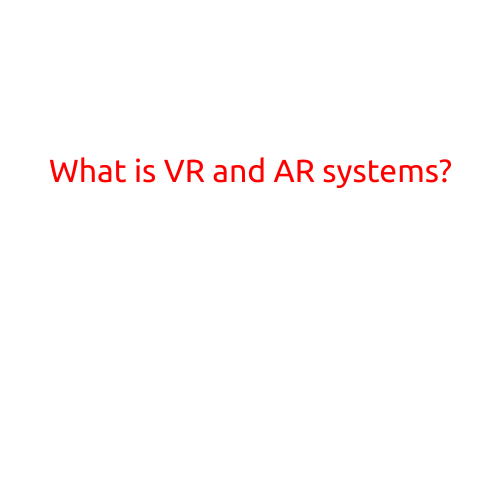
What is VR and AR Systems?
In today’s digital age, technology continues to evolve at an incredible rate, and two technologies that have gained significant attention in recent years are Virtual Reality (VR) and Augmented Reality (AR). Both terms are often used interchangeably, but they have distinct differences and applications. In this article, we will delve into the world of VR and AR, exploring what they are, how they differ, and their potential uses.
What is Virtual Reality (VR)?
Virtual Reality, also known as VR, is a fully immersive digital environment that simulates a three-dimensional (3D) experience. It uses a combination of hardware and software to transport users into a virtual world, often indistinguishable from reality. VR technology is designed to provide an immersive and interactive experience, engaging users’ senses, including sight, sound, and even touch.
VR systems typically consist of:
- Head-Mounted Display (HMD): A headset worn on the head, which displays the virtual environment in a 360-degree view.
- Controllers: Remote controls or gloves that allow users to interact with the virtual environment.
- Software: A special algorithm that generates the 3D environment, allowing users to move around and engage with the virtual world.
Uses of Virtual Reality:
- Gaming: VR is revolutionizing the gaming industry, providing an immersive experience like never before.
- Education: VR is being used in educational settings to enhance learning experiences, such as virtual field trips and interactive simulations.
- Therapy: VR is being used to treat mental health conditions, such as anxiety disorders and PTSD.
- Entertainment: VR is changing the way we watch movies, attend concerts, and enjoy sports.
What is Augmented Reality (AR)?
Augmented Reality, also known as AR, is an interactive technology that superimposes digital information and images over the real world. Unlike VR, AR does not create a completely new environment but rather enhances the real world by adding virtual objects, sounds, or other sensory inputs.
AR systems typically consist of:
- Mobile Device: A smartphone or tablet that displays the AR experience.
- Camera: The device’s camera captures the real-world environment.
- Software: A special algorithm that overlays digital information onto the real-world image.
Uses of Augmented Reality:
- Shopping: AR is changing the way we shop, allowing us to virtually try on clothes, see furniture in our homes, and more.
- Navigation: AR is helping us navigate through cities and public spaces, providing directions and information.
- Healthcare: AR is being used in medical settings to train doctors and patients, as well as to guide surgeries.
- Education: AR is enhancing learning experiences by bringing educational content to life in the real world.
Key Differences:
- Immersiveness: VR is a fully immersive experience, while AR enhances the real world.
- Devices: VR typically requires a dedicated headset, while AR can work on mobile devices.
- Purpose: VR is often used for entertainment, education, and therapy, while AR is used for a wider range of applications, including shopping and navigation.
In conclusion, VR and AR are two distinct technologies that have the potential to revolutionize various aspects of our lives. While VR provides a fully immersive experience, AR enhances the real world. As both technologies continue to evolve, we can expect to see new innovations and applications emerge, transforming the way we interact with information and each other.





